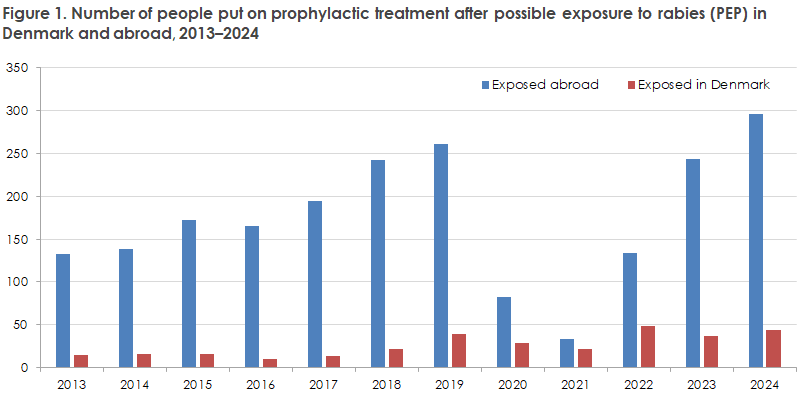Rabies 2024
Rabies Post-Exposure Prophylaxis (PEP) 2024
In 2024, a total of 340 people were considered to have been exposed to potential rabies following animal bites and received rabies post-exposure prophylaxis (PEP). Of these, 18 individuals had previously received Pre-Exposure Prophylaxis (PrEP).
Post-Exposure Prophylaxis given after exposure in Denmark in 2024
In 2024, 44 people received PEP against rabies following possible exposure in Denmark. One of these individuals had previously received PrEP. Among the 44 exposed persons, 33 received human rabies immunoglobulin (HRIG), including one individual who was treated in Sweden.
The most common type of exposure in Denmark was bites or scratches from bats, which accounted for 40 of the cases requiring prophylactic treatment. In addition, two veterinary staff members were bitten by illegally imported, unvaccinated dogs, and two individuals were exposed through other types of contact.
Post-Exposure Prophylaxis given after exposure abroad in 2024
In 2024, a total of 296 individuals received PEP following potential exposure to rabies outside Denmark. Information on the country in which the exposure occurred was available for 280 individuals, while the country of exposure remained unspecified for the remaining 16 cases.
As illustrated in Figure 1, the increase in reported exposures to rabies abroad—which commenced in 2022 following a period of markedly reduced travel activity during the COVID-19 pandemic—continued through both 2023 and 2024.

Among the 296 individuals who were exposed to rabies abroad, 130 (44%) received human rabies immunoglobulin (HRIG), including 52 who were treated only after returning to Denmark.
As in 2022 and 2023, a large proportion of those who received rabies PEP following animal bites abroad in 2024 had been exposed in Thailand (63 cases) or Turkey (52 cases).
In 2024, dogs accounted for 143 (48%) of the potential rabies exposures abroad, while cats were responsible for 82 cases (28%) and monkeys for 42 cases (14%). In addition, five individuals were possibly exposed by bats, and the remaining 11 cases involved other animal species, including raccoon, marmot, horse, hedgehog, bear, lion cub, and civet. For 13 individuals, the type of exposure was not further specified.
Rabies in animals
Rabies is most often caused by classical rabies virus, but can, in rare cases, be due to European Bat Lyssavirus, also called European bat rabies (EBLV types 1 and 2). EBLV is primarily found in bats, but can, although rarely, spread from bats to other mammals. In 2024, there was a case in the Netherlands of EBLV type 1 infection in a cat. Classical rabies continues to occur endemically in large parts of the world, including in parts of Eastern Europe, while it has been eradicated in the western part of Europe. Illegal import of pets from Eastern Europe, North Africa or other areas continues to pose a problem, and cases of rabies in dogs or cats illegally imported into the EU are regularly reported. Classical rabies occurs endemically in Greenland, where polar foxes can spread the infection to other mammals.
Denmark has been free of classical rabies since 1982, while bat rabies, considered sporadic, was first detected in 1985. Most recently, EBLV type 1 was detected in a serotine bat in 2009, while EBLV type 2 was detected in a saliva sample from a Daubenton’s bat in 2015.
In 2024, 36 animals from Denmark were examined for classical rabies and/or bat rabies in passive surveillance. The 36 animals consisted of three cats, one dog, one fox, and 31 bats, of which 16 bats were submitted on suspicion of rabies while 15 were found dead. All examined animals tested negative for rabies by PCR, Table 1.

In 2024, there were five submissions from Greenlandic polar foxes for rabies testing, Table 2. Classical rabies virus was found in all five submitted polar foxes. The examinations of the polar foxes were carried out by the OIE Collaborating Centre for Zoonoses in Europe reference laboratory at the Friedrich-Loeffler-Institut (FLI) in Germany by agreement with Statens Serum Institut.

This report is also mentioned in EPI-NYT 40/2025.